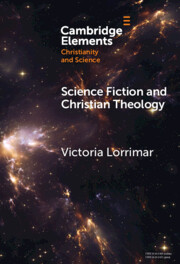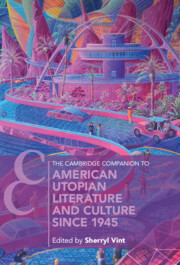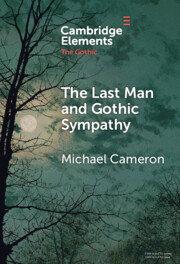Refine search
Actions for selected content:
81 results
Chapter 8 - The Recovery of Genre in Contemporary British Fiction
-
-
- Book:
- The Cambridge Companion to British Postmodern Fiction
- Published online:
- 07 August 2025
- Print publication:
- 21 August 2025, pp 129-143
-
- Chapter
- Export citation
Chapter 20 - Other Worlds and Other Monies
- from Part III - Alternatives
-
-
- Book:
- Money and American Literature
- Published online:
- 03 July 2025
- Print publication:
- 17 July 2025, pp 345-362
-
- Chapter
- Export citation
Chapter 9 - Launching into a Brown Future
- from Part II - Transforming Genres
-
-
- Book:
- Latinx Literature in Transition, 1992–2020
- Published online:
- 19 June 2025
- Print publication:
- 03 July 2025, pp 167-184
-
- Chapter
- Export citation
Chapter 17 - Other/World(ly)
- from Part III - Applications and Extensions
-
-
- Book:
- Space and Literary Studies
- Published online:
- 07 May 2025
- Print publication:
- 22 May 2025, pp 288-302
-
- Chapter
- Export citation
Chapter 18 - Imaginary Space
- from Part III - Applications and Extensions
-
-
- Book:
- Space and Literary Studies
- Published online:
- 07 May 2025
- Print publication:
- 22 May 2025, pp 303-318
-
- Chapter
- Export citation

Science Fiction and Christian Theology
-
- Published online:
- 06 May 2025
- Print publication:
- 29 May 2025
-
- Element
- Export citation
Chapter 10 - Speculative Fiction and the Contemporary Novel
- from Part II - Anglophone Literary Forms
-
-
- Book:
- The Cambridge Handbook of Literature and Plants
- Published online:
- 06 February 2025
- Print publication:
- 13 February 2025, pp 193-212
-
- Chapter
- Export citation
Coconstruire autrement avec des personnes aînées grâce à la science-fiction: nouveaux regards sur la recherche en robotique d’assistance sociale
-
- Journal:
- Canadian Journal on Aging / La Revue canadienne du vieillissement / Volume 44 / Issue 1 / March 2025
- Published online by Cambridge University Press:
- 27 December 2024, pp. 151-157
-
- Article
- Export citation
2 - Turning to Science
-
- Book:
- Steven Weinberg: A Life in Physics
- Published online:
- 22 November 2024
- Print publication:
- 12 December 2024, pp 3-7
-
- Chapter
- Export citation
Revisiting the ‘stability–instability paradox’ in AI-enabled warfare: A modern-day Promethean tragedy under the nuclear shadow?
-
- Journal:
- Review of International Studies , First View
- Published online by Cambridge University Press:
- 20 November 2024, pp. 1-19
-
- Article
-
- You have access
- Open access
- HTML
- Export citation
Values and facts and fancies
-
- Journal:
- Religious Studies , First View
- Published online by Cambridge University Press:
- 19 November 2024, pp. 1-12
-
- Article
-
- You have access
- Open access
- HTML
- Export citation
3 - The Making of the Research Scholar
- from Part II - Approaches to Knowledge
-
- Book:
- Curating the Enlightenment
- Published online:
- 07 December 2024
- Print publication:
- 07 November 2024, pp 63-87
-
- Chapter
- Export citation
24 - Queering Desire in American Science Fiction
- from Queer Genre
-
-
- Book:
- The Cambridge History of Queer American Literature
- Published online:
- 17 May 2024
- Print publication:
- 06 June 2024, pp 426-439
-
- Chapter
- Export citation
Chapter 12 - Environmentalism and Ecotopias
-
-
- Book:
- The Cambridge Companion to American Utopian Literature and Culture since 1945
- Published online:
- 09 May 2024
- Print publication:
- 16 May 2024, pp 217-236
-
- Chapter
- Export citation
Chapter 2 - American Futures
-
-
- Book:
- The Cambridge Companion to American Utopian Literature and Culture since 1945
- Published online:
- 09 May 2024
- Print publication:
- 16 May 2024, pp 41-61
-
- Chapter
- Export citation
Chapter 1 - Pandemics and the Lesson of History
-
-
- Book:
- The Cambridge Companion to American Utopian Literature and Culture since 1945
- Published online:
- 09 May 2024
- Print publication:
- 16 May 2024, pp 23-40
-
- Chapter
- Export citation

The Cambridge Companion to American Utopian Literature and Culture since 1945
-
- Published online:
- 09 May 2024
- Print publication:
- 16 May 2024

The Last Man and Gothic Sympathy
-
- Published online:
- 22 February 2024
- Print publication:
- 28 March 2024
-
- Element
- Export citation
Chapter 19 - The Left Hand of Darkness (1969): Ursula K. Le Guin
- from Part III - Case Studies
-
-
- Book:
- The Cambridge Companion to the Twentieth-Century American Novel and Politics
- Published online:
- 07 October 2023
- Print publication:
- 12 October 2023, pp 285-296
-
- Chapter
- Export citation
Chapter 9 - Science Fiction
- from Part II - The Politics of Genre and Form
-
-
- Book:
- The Cambridge Companion to the Twentieth-Century American Novel and Politics
- Published online:
- 07 October 2023
- Print publication:
- 12 October 2023, pp 142-159
-
- Chapter
- Export citation
